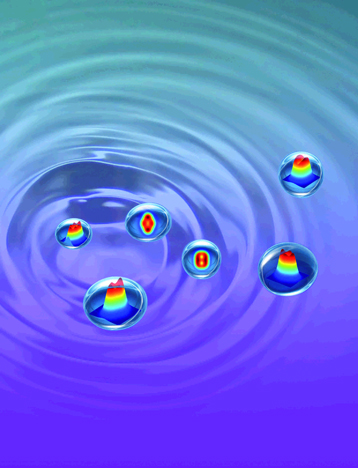Aug
2
A New Way to Think About the Atomic Nucleus
August 2, 2012 | Leave a Comment
To clear that up, the atomic nucleus is generally described as a drop of quantum liquid with a diameter of around a million billionth of a meter. The liquid-like behavior explains nuclear fission, and applies especially to heavy nuclei, i.e. nuclei that contain a large number of nucleons (neutrons and protons) with thorium and uranium as oft thought of examples.
On the other hand, light nuclei can behave like tiny ‘molecules’, or clusters, made up of neutrons and protons within the nucleus. This molecular aspect makes it possible to understand the stellar synthesis of carbon-12 and other heavier elements necessary for the appearance of life.
Until the team published their paper in Nature last month, both the ‘molecule-nucleus’ and the ‘liquid-nucleus’ views coexisted.
The team is now proposing a unified view of these two aspects. By solving quantum physics equations on the scale of the nucleus (in particular the Schrödinger equation), the researchers have demonstrated that, although a light nucleus can show molecule-like behavior (tending towards the crystalline state), heavier nuclei take on a liquid-like behavior.
The effect of solving the Schrödinger equation lends great credibility to the concept.
The paper abstract highlights the clustering phenomena in nuclei where in some cases finite nuclei behave like molecules composed of clusters of protons and neutrons. Observation shows lighter nuclei behave more like molecules composed of clusters of protons and neutrons. Clustering is related to the overall nuclear interaction, but its detailed mechanism is not fully understood.
In the team’s experiments they found that the depth of the confining nuclear potential plays an important part in cluster formation, with a particularly pronounced effect for relativistic functionals. That’s a pretty technical explanation, so think that generally its proposed clustering is considered as a transitional phenomenon between light element nuclei crystalline and quantum heavy element nuclei liquid phases.
The press release quotes using the neutron star for an analogy. So hang on . . .
“The deeper you go inside a neutron star, the more you pass from a crystalline medium to a liquid medium. Thanks to this analogy, the physicists identified a mechanism of transition from the liquid to the crystalline state in the nucleus. When the interactions between neutrons and protons are not strong enough to fix them within the nucleus, the latter is in a quantum-liquid type state where protons and neutrons are delocalized. Conversely, in a crystalline state, neutrons and protons are fixed at regular intervals within the nucleus. The nuclear molecule is interpreted as being an intermediate state between a quantum liquid and a crystal.”
The idea over time is to attain a unified understanding of the various states of the nucleus.
The key in all this that peaked your humble writer’s interest is the abstract points out, “Clustering is a recurrent feature in light nuclei, from beryllium to nickel. Cluster structures are typically observed as excited states close to the corresponding decay threshold; the origin of this phenomenon lies in the effective nuclear interaction, but the detailed mechanism of clustering in nuclei has not yet been fully understood.”
That just begs questions about LENR and other cold fusion processes and how the new view on nuclei may offer routes to explain what happens. At the periodic table region where crystalline gives way to the liquid state there may be much more opportunity than we can imagine today.
The idea is now out. Soon we’ll get more to chew on. Great news, indeed.


